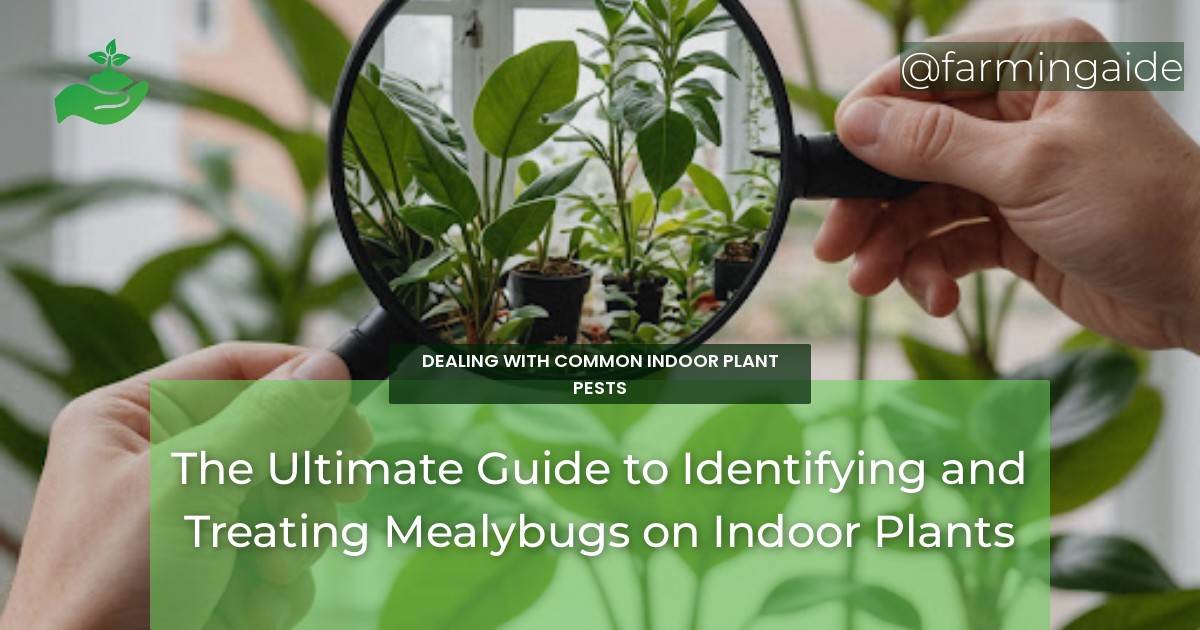Are you tired of dealing with pesky mealybugs on your beloved indoor plants? These tiny, white, cotton-like pests can wreak havoc on your plants, causing damage, discoloration, and even death. But fear not! With the right knowledge and techniques, you can identify, treat, and prevent mealybug infestations, ensuring the health and thriving of your indoor garden. In this ultimate guide, we’ll delve into the world of mealybugs, exploring their life cycle, signs of infestation, effects on plants, and most importantly, effective treatment options and preventive measures to keep these pests at bay.
Key Takeaways
- Mealybugs are small, soft-bodied insects that feed on plant sap, causing damage and discoloration.
- Early detection is crucial in preventing mealybug infestations and reducing treatment time.
- Combining physical removal, organic treatments, and chemical controls can provide effective mealybug management.
- Good indoor plant care practices, such as pruning, isolation, and quarantining, can prevent mealybug infestations.
- Regular monitoring and maintenance are essential for preventing reinfestation.
Understanding Mealybugs
What are Mealybugs?
Mealybugs (Pseudococcidae) are small, soft-bodied insects that feed on plant sap, causing damage and discoloration. These pests are commonly found on indoor plants, particularly those with soft, succulent leaves or stems. Mealybugs are typically white, cotton-like, and can be found on the underside of leaves, stems, or roots.
There are over 200 species of mealybugs, with the most common being the citrus mealybug (Planococcus citri) and the long-tailed mealybug (Pseudococcus longispinus).
Life Cycle of Mealybugs
The life cycle of mealybugs typically consists of three stages: egg, nymph, and adult. Female mealybugs lay eggs in protected areas, such as under leaves or on stems. The eggs hatch into nymphs, which go through several molts before reaching adulthood. Adult mealybugs can live for several months, reproducing and laying eggs throughout their lifetime.
Identifying Mealybug Infestations
ALSO READ
Signs of Mealybug Presence
Early detection is crucial in preventing mealybug infestations and reducing treatment time. Look out for these common signs of mealybug presence:
- White, cotton-like patches or eggs on leaves, stems, or roots.
- Yellowing or distorted leaves.
- Honeydew droplets or sticky residue on leaves or surrounding surfaces.
- Ants or wasps attracted to the honeydew.
Common Host Plants
Mealybugs can infest a wide range of indoor plants, including:
- Succulents and cacti.
- Ferns and peace lilies.
- Orchids and bromeliads.
- Herbs and vegetables.
Effects of Mealybugs on Indoor Plants
ALSO READ
Damage Caused by Mealybugs
Mealybugs feed on plant sap, causing damage and discoloration. This can lead to:
- Yellowing or distorted leaves.
- Reduced plant growth and vigor.
- Increased susceptibility to disease and pests.
- Death of infested plants.
Long-term Impact on Plant Health
Uncontrolled mealybug infestations can have long-term consequences on plant health, including:
- Chronic stress and weakened immune systems.
- Increased risk of disease and pest susceptibility.
- Reduced plant longevity and aesthetic appeal.
Preventive Measures Against Mealybugs
Best Practices for Indoor Plant Care
Good indoor plant care practices can prevent mealybug infestations and reduce the risk of pest and disease issues:
- Prune and isolate infested plants.
- Quarantine new plants before introducing them to your indoor garden.
- Provide good air circulation and lighting.
- Water and fertilize plants appropriately.
Natural Predators and Biological Controls
Natural predators, such as lady beetles and lacewings, can help control mealybug populations. Introduce these beneficial insects into your indoor garden to create a balanced ecosystem.
Treatment Options for Mealybug Infestations
Chemical Treatments
Chemical treatments, such as insecticidal soap and neem oil, can be effective against mealybugs. However, always follow label instructions and take necessary safety precautions.
Organic Solutions
Organic solutions, such as horticultural oil and pyrethrin, offer a safer alternative to chemical treatments. These solutions can be used in conjunction with physical removal methods for optimal results.
Physical Removal Methods
Physical removal methods, such as hand-picking and washing, can be effective against mealybugs. Use a soft-bristled brush or cotton swab to remove mealybugs, and wash plants with mild soap and water.
Recovery and Maintenance After Treatment
Post-Treatment Care for Plants
After treating mealybug infestations, provide your plants with optimal growing conditions, including:
- Adequate light and water.
- Good air circulation and humidity.
- Balanced fertilization.
Monitoring and Preventing Reinfestation
Regularly monitor your plants for signs of mealybug presence and take preventative measures to prevent reinfestation:
- Isolate and quarantine infested plants.
- Use natural predators and biological controls.
- Practice good indoor plant care practices.
Conclusion and Further Resources
Summary of Key Points
In this ultimate guide, we’ve covered the identification, treatment, and prevention of mealybug infestations on indoor plants. Remember to:
- Identify mealybugs early to prevent infestations.
- Combine physical removal, organic treatments, and chemical controls for effective mealybug management.
- Practice good indoor plant care practices to prevent mealybug infestations.
- Monitor and maintain your plants regularly to prevent reinfestation.
Where to Find Additional Help and Information
For more information on mealybug identification, treatment, and prevention, consult with local nurseries, gardening experts, or online resources, such as:
- Local Cooperative Extension offices.
- Online gardening forums and communities.
- Reputable gardening websites and blogs.
By following the guidelines and tips outlined in this ultimate guide, you’ll be well-equipped to identify, treat, and prevent mealybug infestations, ensuring the health and thriving of your indoor garden.


